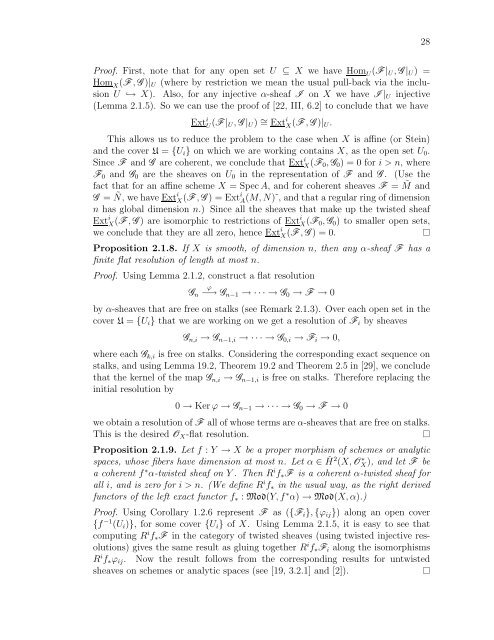derived categories of twisted sheaves on calabi-yau manifolds
derived categories of twisted sheaves on calabi-yau manifolds
derived categories of twisted sheaves on calabi-yau manifolds
Create successful ePaper yourself
Turn your PDF publications into a flip-book with our unique Google optimized e-Paper software.
Pro<str<strong>on</strong>g>of</str<strong>on</strong>g>. First, note that for any open set U ⊆ X we have Hom U(F |U, G |U) =<br />
Hom X(F , G )|U (where by restricti<strong>on</strong> we mean the usual pull-back via the inclusi<strong>on</strong><br />
U ↩→ X). Also, for any injective α-sheaf I <strong>on</strong> X we have I |U injective<br />
(Lemma 2.1.5). So we can use the pro<str<strong>on</strong>g>of</str<strong>on</strong>g> <str<strong>on</strong>g>of</str<strong>on</strong>g> [22, III, 6.2] to c<strong>on</strong>clude that we have<br />
Ext i<br />
U(F |U, G |U) ∼ = Ext i<br />
X(F , G )|U.<br />
This allows us to reduce the problem to the case when X is affine (or Stein)<br />
and the cover U = {Ui} <strong>on</strong> which we are working c<strong>on</strong>tains X, as the open set U0.<br />
Since F and G are coherent, we c<strong>on</strong>clude that Ext i<br />
X(F0, G0) = 0 for i > n, where<br />
F0 and G0 are the <str<strong>on</strong>g>sheaves</str<strong>on</strong>g> <strong>on</strong> U0 in the representati<strong>on</strong> <str<strong>on</strong>g>of</str<strong>on</strong>g> F and G . (Use the<br />
fact that for an affine scheme X = Spec A, and for coherent <str<strong>on</strong>g>sheaves</str<strong>on</strong>g> F = ˜ M and<br />
G = Ñ, we have ExtiX(F<br />
, G ) = Ext i<br />
A(M, N)˜, and that a regular ring <str<strong>on</strong>g>of</str<strong>on</strong>g> dimensi<strong>on</strong><br />
n has global dimensi<strong>on</strong> n.) Since all the <str<strong>on</strong>g>sheaves</str<strong>on</strong>g> that make up the <str<strong>on</strong>g>twisted</str<strong>on</strong>g> sheaf<br />
Ext i<br />
X(F , G ) are isomorphic to restricti<strong>on</strong>s <str<strong>on</strong>g>of</str<strong>on</strong>g> Ext i<br />
X(F0, G0) to smaller open sets,<br />
we c<strong>on</strong>clude that they are all zero, hence Ext i<br />
X(F , G ) = 0.<br />
Propositi<strong>on</strong> 2.1.8. If X is smooth, <str<strong>on</strong>g>of</str<strong>on</strong>g> dimensi<strong>on</strong> n, then any α-sheaf F has a<br />
finite flat resoluti<strong>on</strong> <str<strong>on</strong>g>of</str<strong>on</strong>g> length at most n.<br />
Pro<str<strong>on</strong>g>of</str<strong>on</strong>g>. Using Lemma 2.1.2, c<strong>on</strong>struct a flat resoluti<strong>on</strong><br />
Gn<br />
ϕ<br />
−→ Gn−1 → · · · → G0 → F → 0<br />
by α-<str<strong>on</strong>g>sheaves</str<strong>on</strong>g> that are free <strong>on</strong> stalks (see Remark 2.1.3). Over each open set in the<br />
cover U = {Ui} that we are working <strong>on</strong> we get a resoluti<strong>on</strong> <str<strong>on</strong>g>of</str<strong>on</strong>g> Fi by <str<strong>on</strong>g>sheaves</str<strong>on</strong>g><br />
Gn,i → Gn−1,i → · · · → G0,i → Fi → 0,<br />
where each Gk,i is free <strong>on</strong> stalks. C<strong>on</strong>sidering the corresp<strong>on</strong>ding exact sequence <strong>on</strong><br />
stalks, and using Lemma 19.2, Theorem 19.2 and Theorem 2.5 in [29], we c<strong>on</strong>clude<br />
that the kernel <str<strong>on</strong>g>of</str<strong>on</strong>g> the map Gn,i → Gn−1,i is free <strong>on</strong> stalks. Therefore replacing the<br />
initial resoluti<strong>on</strong> by<br />
0 → Ker ϕ → Gn−1 → · · · → G0 → F → 0<br />
we obtain a resoluti<strong>on</strong> <str<strong>on</strong>g>of</str<strong>on</strong>g> F all <str<strong>on</strong>g>of</str<strong>on</strong>g> whose terms are α-<str<strong>on</strong>g>sheaves</str<strong>on</strong>g> that are free <strong>on</strong> stalks.<br />
This is the desired OX-flat resoluti<strong>on</strong>.<br />
Propositi<strong>on</strong> 2.1.9. Let f : Y → X be a proper morphism <str<strong>on</strong>g>of</str<strong>on</strong>g> schemes or analytic<br />
spaces, whose fibers have dimensi<strong>on</strong> at most n. Let α ∈ ˇ H2 (X, O∗ X ), and let F be<br />
a coherent f ∗α-<str<strong>on</strong>g>twisted</str<strong>on</strong>g> sheaf <strong>on</strong> Y . Then Rif∗F is a coherent α-<str<strong>on</strong>g>twisted</str<strong>on</strong>g> sheaf for<br />
all i, and is zero for i > n. (We define Rif∗ in the usual way, as the right <str<strong>on</strong>g>derived</str<strong>on</strong>g><br />
functors <str<strong>on</strong>g>of</str<strong>on</strong>g> the left exact functor f∗ : Mod(Y, f ∗α) → Mod(X, α).)<br />
Pro<str<strong>on</strong>g>of</str<strong>on</strong>g>. Using Corollary 1.2.6 represent F as ({Fi}, {ϕij}) al<strong>on</strong>g an open cover<br />
{f −1 (Ui)}, for some cover {Ui} <str<strong>on</strong>g>of</str<strong>on</strong>g> X. Using Lemma 2.1.5, it is easy to see that<br />
computing R i f∗F in the category <str<strong>on</strong>g>of</str<strong>on</strong>g> <str<strong>on</strong>g>twisted</str<strong>on</strong>g> <str<strong>on</strong>g>sheaves</str<strong>on</strong>g> (using <str<strong>on</strong>g>twisted</str<strong>on</strong>g> injective resoluti<strong>on</strong>s)<br />
gives the same result as gluing together R i f∗Fi al<strong>on</strong>g the isomorphisms<br />
R i f∗ϕij. Now the result follows from the corresp<strong>on</strong>ding results for un<str<strong>on</strong>g>twisted</str<strong>on</strong>g><br />
<str<strong>on</strong>g>sheaves</str<strong>on</strong>g> <strong>on</strong> schemes or analytic spaces (see [19, 3.2.1] and [2]).<br />
28
















